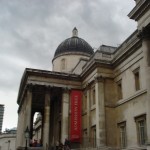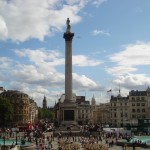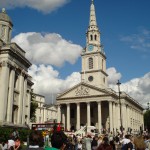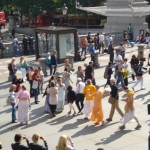Today’s class centered around a discussion of how immigrant and minority populations in London have either struggled or been able to assimilate. We examined specific groups and religions and attempted to define exactly what assimilation entails. Kelley brought up a great point about how some groups that come to London have no interest in assimilation. They come simply to get an education, make some money and share what they’ve learned once they return to their country of birth. This complicates the assimilation process even more. What can we do as educated young people to help minority groups achieve assimilation? Do they want our help at all? These are some questions I am going to continue to wrestle with for the remainder of my time in the U.K.
After class today I had an afternoon filled with art, both musical and visual. A lunchtime concert at historic St. Martin in the Fields featured a fantastic three man ensemble called E.L.F. Made up of a pianist Geoff Eales, french horn player Dave Lee and flautist Andy Findon the group put on an incredible performance highlighted by an extraordinary 40 minute take on Andrew Lloyd Webber’s “The Phantom of the Opera”. The music was moving and captivating throughout and at the end of “All I Ask of You” I was left with goosebumps from head to toe. As someone who played trumpet and a little bit of French Horn throughout high school I was amazed by the richness of the sound Mr. Lee produced. It was superior to anything I had ever heard performed in the past. The church’s incredible acoustics certainly had a major impact on the groups resounding sound as well turning a three man ensemble into what sounded like a full fledged orchestra. One action that took place during the concert that Brandon and I were pondering was whether it is customary for performers to exit the stage completely while the audience applauds and then return for the next number shortly after. We were unsure if this was something unique to England, unique to St. Martins in the Fields or whether the group chose to do so at their own discretion. In any event it was something we had never seen before.
After the concert Aidan, Brandon and I headed over to the National Gallery where we gazed at thousands of works of art from all different countries and time periods. I do not know much about visual art and what techniques are used to make paintings considered great but I was continually amazed and impressed by the amount of detail these artists put into their work. Even the smallest stroke of a paintbrush can change a painting entirely. We spent a number of hours inside the National Gallery gazing at everything from Van Gogh to Manet to Van Brugh. Visual art is not my forte nor my specialty but I was very impressed and would go back to the museum in a heartbeat.
After our tour of the National Gallery we headed back out to Trafalgar Square. The rain had let up and the square was alive with all kinds of people. There was protesting, dancing, singing and any number of exciting things going on. We took an abundance of pictures while in the area, attempting to catch all the excitement that was taking place as well as capturing the various monuments in the area such as Nelson’s Column and St. Martin in the Fields.
The final stop in our afternoon included a tour of the National Portrait Gallery, just down the road from St. Martin in the Fields. Inside we viewed portraits of everyone from Princess Diana to T.S. Eliot. My favorite part of the portrait gallery was the section they featured on the Bloomsbury Group. Portraits of Virginia Woolf, E.M. Forster and Lytton Strachey just to name a few were found inside this area. After going on the Bloomsbury walk the day before with Professor Qualls the information was still fresh in my mind and I was able to make connections between the tour and the exhibit. This was fascinating.
I can safely say that this has been my favorite day in London so far. A stimulating discussion, an unbelievable concert, a walk through an internationally recognized museum and time spent with friends adds up to a wonderful and busy day. I hope that the rest of our time spent in London will follow suit.
Tags: Churches and Cathedrals · Henry · Museums
 Picture: Names of ships, sailing ports, number of slaves on board and place of arrival; from Docklands Museum
Picture: Names of ships, sailing ports, number of slaves on board and place of arrival; from Docklands Museum
A short clip at the Docklands Museum opened up with the question: “Who are you?” It asked us to think about the feeling of being taken to a foreign place against your will to be violated, beaten, mistreated and even sold. It asked us to think about loosing everything you have ever worked for, everything you own, everything and everyone you love. The film also asked us to “consider slavery how bitter a draught and how many are forced to drink it” (from short film). I have thought about these questions multiple times before and I will never know what it was like to be in one of the 10,000 ships (as a slave) which left Britain for the Triangle Trade between 1642 and 1812.
Since my arrival in London, I have inquired about London’s dark history, the unpopular history, the history that no one wants to discuss, exactly the history on display at the Docklands. Yesterday, while at the Museum of London, as I read through a small exhibit on Apartheid I was reminded of the atrocities committed in South Africa and today I was reminded once again. Although, the small exhibit appeared to be focused on the contributions of Englishmen and women to the fight against the Apartheid government, it sparked a special interest in me. Today at the Docklands Museum, I was able to answer some of my own questions from yesterday regarding London’s role in the enforcement of segregation and the slave trade.
“The white men’s happiness cannot be purchased by the black men’s misery.” (Frederick Douglas, 1849) Indeed, Frederick Douglas was and still is correct in this statement and I think the Docklands Museum makes a great attempt to teach everyone just that. I am pleased to have learned this side of London’s history, the one A.N. Wilson would refer to as “hidden beneath the surface,” the one that Bloomsbury tells nothing of.
On our admirable tour of Bloomsbury I realized that this is a town filled with its own rich history, yet it is a history I was not too eager to learn. Even though, during the tour I was very much intrigued by the numerous Squares we visited and by the historical sites we discussed It was not my favorite place at the moment. I guess I’m not used to living and learning about a place where so many popular writers and influential people have lived in. I thought about how wealthy this area is and has been, and wealth is not something I personally admire. Regardless of my personal feelings, the town was a joy to explore and nifty to get to know, nevertheless I am almost sure there is some lost history in Bloomsbury too!
In class today Professor Qualls asked us to walk away considering the following questions: What does London do to people? and What happens when you come to London? Well, London certainly may have done something to those who sailed from the docklands towards the United States on slave ships, to the slaves themselves, to the people who fought (in London) for the end of Apartheid in South Africa and to those who were inspired and wrote their best work on the streets of Bloomsbury. London is making me questions British History, what is told as well as what remains hidden (not in our books). Now ask yourself, Who are you? and What is London doing to you?
I end with a quote from the Docklands Museum by Ottobah Cugoano (1787): “It is not strange to think, that they who ought to be considered as the most learned and civilized people in the world, that they should carry on a traffic of the most barbarous cruelty and injustice, and that many… are become so dissolute as to think slavery, robbery and murder no crime?”
Tags: Flow · Uncategorized
Today we took a walking tour of Bloomsbury. Before beginning I had no idea what to expect; I truly did not realize the amount of history that is so close to the Arran House. The amount of famous people who lived or worked in Bloomsbury is impressive. Whether it was John Maynard Keynes, Bertrand Russell, George Orwell or Virginia Woolf, you can’t but be impressed. I found it especially eerie that the Senate House of the University of London where Orwell worked and learned the in’s and out’s of propaganda really did give the the feeling of the “Ministry of Truth.” In the end, it is amazing to think that where you just walked could have been the same place as where one of the aforementioned individuals did so as well.
Perhaps what most interested me was the evolution of the Squares and the Square Gardens. What once was an exclusive membership reserved for only those in a particular Square now is open to everyone. It is obvious the class plays an important role throughout British history, but it fascinating to see how the dynamics of class change. I was particularly struck by a statue of Gandhi. The statue seems out of place yet shows how the British deal with their feelings about their past. Even with this, the statue was transformed into a symbol of peace and non-violence when the 7/7 attacks occurred. People gathered to mourn the attacks and lay flowers around a figure who was at one time seen as an enemy of British power. The transformation from enemy to symbol of peace and non-violence is remarkable.
Tags: Andrew F
When I first left Tower Hill Tube station and looked out over the road to the Tower of London, my first thought was “I really wish those cars weren’t driving on the road so I could get a clear picture.” Then I managed to get over my disappointment, reminding myself that I will be going there eventually and will be able to take pictures in abundance, I looked around and noticed the section of Roman Wall standing less than 100 feet to my left. I admit, knowing the importance of the Romans and the impact their wall had on the development of today’s London, I feel kind of silly for letting my eyes slide over it to the prettier and more picturesque Tower. That written, I think that my mistake of dismissing the wall as nothing but an unimportant ruin happens to countless tourists and even the people of London every day!

Roman Wall my eyes skimmed in favor of the Tower of London
What I found most interesting about the Roman Walk was the idea that London is a modern city built on top of several stages of ancient city. The fact that the basement of a hair salon can house Roman ruins is difficult to fathom. However, the knowledge that people in the medieval ages recognized the brilliance of Roman engineering and decided to fortify and expand the existing wall is even more incredible.

Medieval section built on top of Roman Wall - complete with pigeons!
When I started my second of two walks of yesterday, I didn’t know very much about the area or the people who have lived there. Although it was really neat to see where this writer and that philosopher worked and played, I was much more interested in the buildings and how they related to the history of London. There was one section of the tour that particularly captured my attention. When standing in the centre of one of the green spaces, you could look to one side and see original row houses, with the dark brown brick and white window frames, and to the other side you could only see bright red brick houses that seemed to have been completed in the last five to ten years. The original houses that still stand were only cosmetically damaged during the Blitz; while the red brick homes had been completely annihilated. What shocked me was that only a small span of grass and trees separated the barely injured and the completely destroyed.

Original rowhouses that were barely damaged in the Blitz

New red brick rowhouses where old ones were destroyed in the Blitz
Today at the Docklands Museum, the City and River: 1800-1840 exhibit really stood out. I’m not a huge fan of taxes and duties, but there was a section on customs and why the docks had to be formed that made a lot of sense to me. It explained that there was so much illegal shipping into London through unauthorized channels that something had to be done by the government to try to control it/use it to their advantage to get more money through taxes. What I found particularly interesting was that the proprietors of the different docks were paranoid of each other to a fault. They didn’t trust the police to look after their docks and warehouses, so they hired personal security forces to keep out anyone they didn’t want around. After seeing the different wharfs and how close they were to each other when I went up to Greenwich the other day, I completely understand the paranoia of the businessmen.
Even though I’ve been in London for only four days, I feel like I’m slowly beginning to understand that there is much more the London than I could have possibly imagined. I’m learning that I need to keep my eyes open because you never know when you’ll turn a corner and find the next nugget of history, culture, art, or architecture.
Tags: Kelley





 Picture: Names of ships, sailing ports, number of slaves on board and place of arrival; from Docklands Museum
Picture: Names of ships, sailing ports, number of slaves on board and place of arrival; from Docklands Museum


